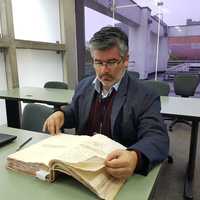José Carlos de la Puente
Texas State University, History, Faculty Member
Este libro explora el mundo de los viajeros andinos a la corte de los Habsburgo. El estudio presenta estos viajes a través del Atlántico Ibérico a la vez como un reflejo de los profundos cambios operados en las sociedades indígenas... more
Este libro explora el mundo de los viajeros andinos a la corte de los Habsburgo. El estudio presenta estos viajes a través del Atlántico Ibérico a la vez como un reflejo de los profundos cambios operados en las sociedades indígenas andinas tras la Conquista y como un poderoso catalizador de estas transformaciones, con implicancias en ambas orillas del océano. El libro transporta a los lectores desde los llamados “pueblos de indios” hacia la corte virreinal y, en último término, la corte real en Madrid en donde, a través de la efectiva apropiación y redefinición de los espacios judiciales diseñados para los vasallos “indios” del rey en el siglo XVI, los viajeros, litigantes y pretendientes que emprendieron el largo camino desde los Andes a Europa ayudaron a redefinir también espacios políticos y sociales. Estos espacios darían expresión, ya en el siglo XVII, a la llamada Nación Índica, una comunidad política supuestamente autónoma e inclusiva que, en realidad, daba expresión a la nueva élite india del reino, articulada desde la ciudad de Lima y forjada precisamente a partir de estos viajes y de los procesos históricos que desencadenaron.
Research Interests:
After the Spanish victories over the Inca claimed Tawantinsuyu for Charles V in the 1530s, native Andeans undertook a series of perilous trips from Peru to the royal court in Spain. Ranging from an indigenous commoner entrusted with... more
After the Spanish victories over the Inca claimed Tawantinsuyu for Charles V in the 1530s, native Andeans undertook a series of perilous trips from Peru to the royal court in Spain. Ranging from an indigenous commoner entrusted with delivering birds of prey for courtly entertainment to an Inca prince who spent his days amid titles, pensions, and other royal favors, these sojourners were both exceptional and paradigmatic. Together, they shared a conviction that the sovereign’s absolute authority would guarantee that justice would be done and service would receive its due reward. As they negotiated their claims with imperial officials, Amerindian peoples helped forge the connections that sustained the expanding Habsburg realm’s imaginary and gave the modern global age its defining character.
Andean Cosmopolitans recovers these travelers’ dramatic experiences, while simultaneously highlighting their profound influences on the making and remaking of the colonial world. While Spain’s American possessions became Spanish in many ways, the Andean travelers (in their cosmopolitan lives and journeys) also helped to shape Spain in the image and likeness of Peru. De la Puente brings remarkable insights to a narrative showing how previously unknown peoples and ideas created new power structures and institutions, as well as novel ways of being urban, Indian, elite, and subject. As indigenous people articulated and defended their own views regarding the legal and political character of the “Republic of the Indians,” they became state-builders of a special kind, cocreating the colonial order.
Andean Cosmopolitans recovers these travelers’ dramatic experiences, while simultaneously highlighting their profound influences on the making and remaking of the colonial world. While Spain’s American possessions became Spanish in many ways, the Andean travelers (in their cosmopolitan lives and journeys) also helped to shape Spain in the image and likeness of Peru. De la Puente brings remarkable insights to a narrative showing how previously unknown peoples and ideas created new power structures and institutions, as well as novel ways of being urban, Indian, elite, and subject. As indigenous people articulated and defended their own views regarding the legal and political character of the “Republic of the Indians,” they became state-builders of a special kind, cocreating the colonial order.
